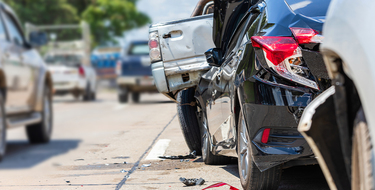
Any type of rear-end collision can lead to severe and permanent injuries. This is because these accidents happen very suddenly, causing the body to experience extreme force and impact quickly with no warning. Therefore, when a car rear-ends you at high speed, you can sustain personal injuries that make take weeks, months, or even years to truly heal – if they ever fully heal at all.
Here are eight common but serious injuries from rear-end accidents:
When a vehicle rear-ends the back of your car, your neck may rapidly move back and forth. This can cause severe neck injuries and whiplash. A few of the signs that may indicate you have whiplash are pain in the neck or shoulders, headaches, tingling, numbness, neck stiffness, inability to move your neck, back pain, and more. It is very important that you do not ignore any of these symptoms because they will only get worse. In fact, many people need surgery to repair serious neck injuries.
If you have been rear-ended, your head and face could be pushed forward, causing you to hit the dashboard, airbag, steering wheel, or other objects in the car. This can lead to severe facial, dental, and eye injuries, which often result in permanent scarring and disfigurement. Most people need several surgeries to repair these types of injuries. However, even with surgery, their face, teeth, and eyes may never look or feel the same again.
Individuals who are rear-ended may experience traumatic brain injuries (TBIs). The reason for this is because their head strikes the steering wheel, window, dashboard, airbag, windshield, or other hard objects within the vehicle. A traumatic brain injury is very serious. Therefore, it is recommended to get medical treatment from a doctor as soon as possible to rule one out or to help alleviate your symptoms if you have a TBI. Some of the symptoms that a person with a traumatic brain injury may experience are headaches, nausea, vomiting, feeling dizzy, speech issues, feeling tired, and more.
Back and spinal cord injuries are very common in rear-end collisions. This is because the individual who is rear-ended experiences a sudden blow to the back, which can result in bulging discs, damaged nerves, or an injured spinal cord. As a result, they may have long-term complications for the rest of their lives, such as paralysis, chronic pain, infections, and more.
When a person is involved in an accident, they may become trapped and crushed under or inside the vehicle. This not only may lead to severe crushing injuries, but it can also cause the individual to need a limb amputated to save their life. In addition, severe cuts and lacerations can lead to the amputation of body parts.
Another common type of injury that victims of rear-end accidents suffer are broken and fractured bones. Most people who survive these accidents end up having broken or fractured arms, legs, ribs, necks, wrists, fingers, toes, hips, and more. Therefore, they may be required to undergo surgeries, participate in physical therapy programs, and wear casts for long periods.
While most people only think about bones breaking during car accidents, the truth is that many people experience soft tissue injuries as well. These types of injuries can affect the muscles, nerves, tendons, ligaments, and more. As a result, rear-end accident victims often suffer severe bruising, strains, sprains, and torn muscles, which are all considered to be soft tissue injuries.
Individuals involved in rear-end accidents are also prone to internal organ damage. The reason for this is because they may experience a strong impact or blow to their organs, leading to severe injuries and damage. The most common organs that become damaged in rear-end collisions are the kidneys, liver, and lungs, due to seat belt or steering wheel injuries.
Rear-end collisions can happen due to various reasons. However, the driver who rear-ended the other driver is usually found liable. The following are a few of the most common reasons why these types of accidents occur:
If you have been in a rear-end collision and need help proving negligence, consider hiring a car accident lawyer at your earliest opportunity. Lawyers are trained and educated on these types of accidents. Therefore, they have the skills and knowledge to show that the accident was not your fault, communicate with insurance companies, hold the responsible parties accountable for their behaviors, and fight for the compensation you are owed. If you are ready to get the help you deserve, schedule a meeting with an experienced car accident attorney today.
